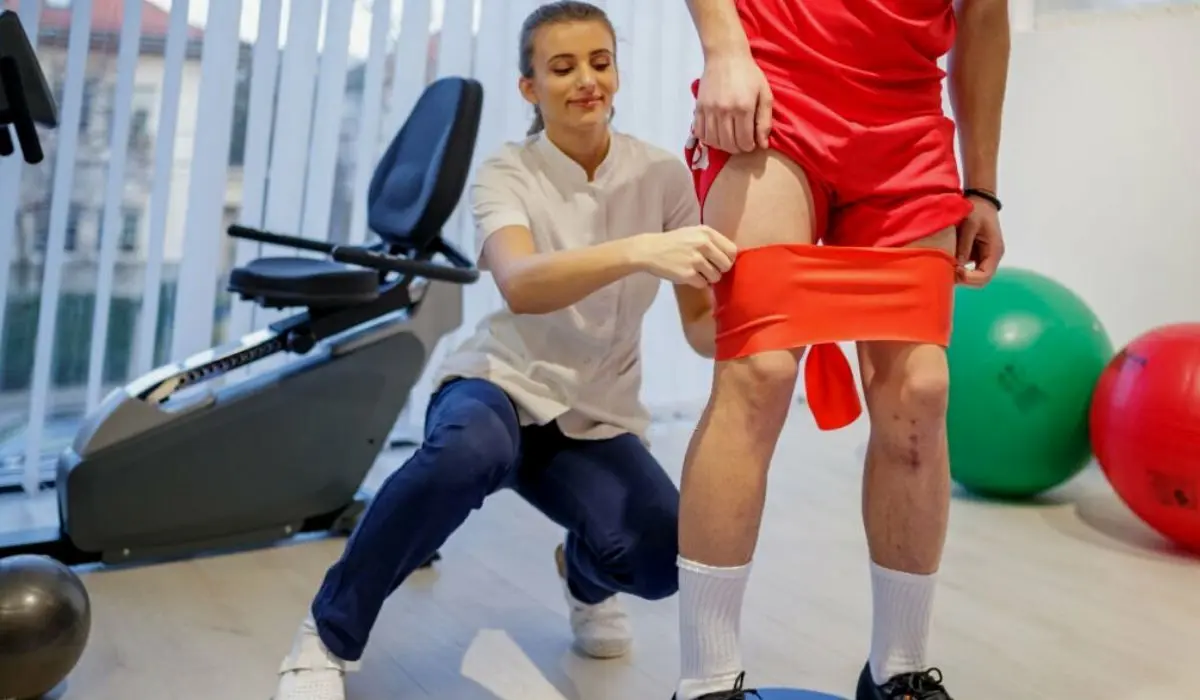Football is a challenging physical sport, so injuries happen frequently. When a football player is hurt, it’s crucial to have an accurate rehabilitation plan in place to help in their quickest and safest return to the game.
Football player rehabilitation has the following aims:
- Lessen discomfort and inflammation
- Regain flexibility and strength
- Balance and proprioception are improved
- Avoid further injury
10 Rehabilitation Strategies For Quick Recovery Of Football Player
Football players can recover from injuries using a variety of specialized rehabilitation routines in addition to general concepts. These exercises are intended to increase the range of motion and strengthen the muscles and connective tissues surrounding the damaged area.

Here are some rehabilitation strategies for football players:
1] Nutrition And Hydration
Football players should consume a lot of fluid ( approximately 150% of sweat loss ) as soon as possible after the match ends, along with flavored milk and tart cherry or berry juice and a lot of sodium (around 500-700 mg/L of water).
Then, within an hour of the match, they should consume a meal that must be high in protein and carbohydrates with a high glycemic index. Drinking proper water and consuming protein, vitamin, and carbohydrate-rich diets can help players for early rehabilitation.
2] Sleep
Taking proper sleep can help in the early recovery of players, and sleep is an essential part of recovery management. Sleep disturbance after and before the match is widespread, and that’s why they also negatively affect recovery. Football players should aim to get 7-8 hours of sleep daily.
3] Cold Water Immersion
Cold water immersion is a therapeutic method that involves briefly immersing the body in cold water. It is effective in reducing pain and inflammation, improving muscle recovery and boosting the immune system.
To perform cold water immersion, fill a bathtub or basin with cold water (50-59 degrees Fahrenheit). Immerse the injured body part in the water for 10-15 min. For better effect, it is recommended to perform this activity multiple times per day.
4] Active Recovery
Active recovery is a rehabilitation strategy that involves performing a light physical activity to promote healing, and it involves walking, swimming, and cycling.
Active recovery exercises should be performed at a low intensity and should not cause any pain. The goal of active recovery is to promote blood flow to the injured area and to help the body heal.
5] Massage
Massage therapy can help to reduce inflammations and pain, improve range of motion, and promote relaxation. Massage therapy is performed by a professional massage therapist or by players themselves.
There are a variety of massage techniques that can be used for football players’ rehabilitation. Some standard techniques include stroking, kneading, and rubbing.
6] Stretching
Stretching is an important part of any rehabilitation program, and it helps to improve the range of motion and flexibility. This will also help in releasing muscle tension. There are a variety of stretching exercises that are used by football players in rehabilitation.
7] Compression Garments
Compression garments can help to reduce swelling and improve circulation to the injured area. Compression garments can be worn throughout the day and during activities. Some common types of compression garments for football players include compression sleeves, compression shorts, and compression socks.
8] Electrical Stimulations
Electrical stimulation is a rehabilitation strategy that uses electrical current to promote healing. Electrical stimulations can be used to reduce pain, improve muscle strength, and increase range of motion.
It is performed by a physical therapist or by the players themselves. There are a variety of electrical stimulation devices available for home use.
9] Strength Training Session
Strength training session is an important rehabilitation program; strength training helps to improve muscles around the injured area and to improve stability.
10] Foam Roller
Foam roller is a self-massage technique that can be used to improve the range of motion, reduce muscle tension, and promote relaxation. Foam rolling can be used in any part of the body, but it is commonly used in the legs and back.
Conclusion
Following these rehabilitation strategies can help football players to make a full recovery from injury. It is important to be patient and to follow the advice of the healthcare professional. With the right rehabilitation plan, football players can return to their game safely and quickly. Always be patient; rehabilitation takes time.